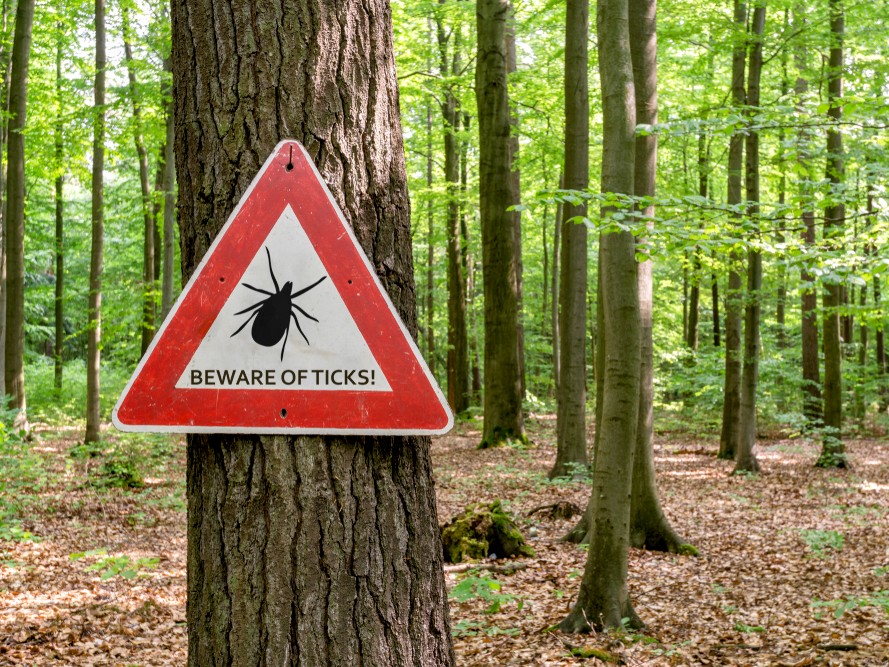
Ticks are highly resilient to extreme temperatures
Blacklegged ticks (Ixodes scapularis) are well-known carriers of pathogens that are responsible for a variety of diseases, including Lyme disease, the most common vector-borne illness in North America.
Over the past years, these ticks have significantly expanded their range across the Eastern United States and Midwest, challenging previous assumptions regarding their preferred habitats. While climate change has often been hailed responsible for these range shifts, it is not yet clear why ticks are abundant in some areas and rare in others.
To better understand how changes in temperature affect ticks, a team of researchers led by Washington State University (WSU) has set up a large field study at three military bases across the U.S. East Coast. The results are published in the journal Ecological Monographs.
How the research was conducted
By placing over 9,000 ticks in soil core enclosures and closely monitoring their survival and development during a period of three years, the experts found that these parasites are much more resilient to extreme temperatures than previously thought.
Although prior laboratory research suggested that even short periods of particularly warm or cold conditions should easily kill ticks, the new study found that this is only the case for their larvae. By contrast, nymph and adult ticks appeared to survive extreme temperatures with relative ease, dying only when they ran out of energy.
“We thought we would see some evidence that if there was like a very dry period, all the ticks might be at a greater risk of dying,” said lead author Jesse Brunner, an associate professor of Biological Sciences at WSU. “However, just the larvae were impacted by heat and dry conditions. Cold weather had even less of an impact. Somehow, they hunker down and survive great.”
What the experts discovered
The investigation revealed that, although extreme weather conditions do not significantly affect tick mortality, it does make them burn through their food faster, suggesting that hotter weather could shorten the window of time for ticks to locate a potential host walking by. This finding was particularly true for tick larvae, whose median survival times were halved when exposed to frequent periods of hot and dry weather.
Moreover, the scientists were surprised to find that soil core enclosures located just a few meters apart from each other frequently exhibited highly different rates of tick mortality. For instance, while in one container 80 percent of ticks survived, in another located right next to it none of them did. Although the cause of these extreme variations is unclear, environmental factors such as arthropods or fungi could possibly play a major role.
Considering the massive impact of tick-borne diseases on public health, the implications of this study could be far-reaching. For instance, the findings highlight the importance of targeting interventions during the larval stage, when ticks are most vulnerable. Focusing on this stage of development, scientists hope to develop effective strategies, such as vaccinating host species, which can significantly reduce tick populations and mitigate the rates of disease transmission.
More research is needed
Further research is needed to clarify the factors leading to localized tick mortality and the role host species such as mice, deer, and humans play in tick survival.
“The ultimate goal is to develop a comprehensive framework that can predict and effectively manage tick populations. This could in turn lead to improved public health outcomes,” Brunner concluded.
More about black-legged ticks
Black-legged ticks, scientifically known as Ixodes scapularis, are primarily found in the northeastern and midwestern regions of the United States, as well as parts of southeastern Canada. They are also commonly referred to as deer ticks.
Key points about black-legged ticks:
Appearance
Black-legged ticks are small arachnids, with adult females measuring about 3 to 5 millimeters in length, while adult males are slightly smaller. They have a dark brown to black colored body and are characterized by their eight legs.
Habitat
These insects thrive in wooded areas, particularly in forests with a dense understory and abundant leaf litter. They prefer a humid environment and are often found in areas with tall grasses and shrubs.
Life Cycle
Black-legged ticks have a complex life cycle that involves four stages: egg, larva, nymph, and adult. They require a blood meal at each stage to progress to the next. Small mammals, birds, and reptiles typically serve as hosts for the larval and nymphal stages, while larger mammals, including humans, are preferred hosts for adults.
Feeding Habits
Black-legged ticks are parasitic and feed on the blood of animals, including humans. They attach themselves to their hosts by biting into the skin, and their feeding process can last several days. During feeding, ticks can transmit disease-causing pathogens, such as the bacterium responsible for Lyme disease (Borrelia burgdorferi).
Disease Transmission
Black-legged ticks are the primary vectors of Lyme disease in North America. Lyme disease is a bacterial infection that can cause a range of symptoms, including fever, fatigue, headache, muscle and joint aches, and a characteristic skin rash. If left untreated, Lyme disease can lead to more serious complications affecting the joints, heart, and nervous system.
Prevention
To protect yourself from black-legged ticks and reduce the risk of tick-borne diseases, it’s important to take preventive measures. These include wearing long-sleeved shirts, long pants, and closed-toe shoes when venturing into tick-prone areas.
—-
By Andrei Ionescu, Earth.com Staff Writer
Check us out on EarthSnap, a free app brought to you by Eric Ralls and Earth.com.













